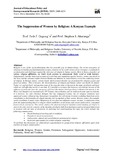| dc.description.abstract | Religion is one of the soc
ial phenomena that has powerful grip on human beings. The recent resurgence of
religious revivalism and fundamentalism in many countries in the world seem to prove resistance to postmodern
secularization and challenges against the relevance of religion in
human society. Here in Kenya, preachers of
various religious affiliations use lunch break sessions to communicate God’s word to ready listeners.
Unfortunately, horrific historical accounts of witch hunt and inquisition against heretics, torture and death i
n
the West, and the constant conflict between Hindus and Muslims in Indian history, reveal the conflicting nature
of religion. In Kenyan history, certain rituals which seemed obsolete are perpetuated by religion as part and
parcel of culture. This is beca
use, the interrelatedness of religion and human culture can hardly be denied.
Today, we can look back, and question some of the atrocities done in the past in the name of religion and those
which are still affecting society in our time. It is possible to n
avigate this trajectory of criticism because of the
influence of modernity since the emergence of French Revolution which questioned orthodox Christianity in the
West; even though it was not until early 19
th
Century when orthodoxy and its tradition became
open to criticism.
It is however, not only Christian Religion that has subjugated women, but all religious traditions have
oppressed women without giving them proper recognition for self esteem; let alone excluding them from active
contribution to the for
mation of cultural meaning and recognition of their society. Kenya
n
women, for example,
rarely
contributes
in major issues. Religion on its own does not subjugate women, because, its oppression stems
from the understanding that it is religion which establi
shes social norms and creates androcentric conceptual
framework for patriarchy.
This article employs the phenomenological stipulative understanding of religion to
answer the emic and etic concerns of the meaning of religion both from theological and sociol
ogical dimensions
to resonate with our topic of discussion. In analyzing and contextualizing this topic, the article includes the
following common areas:
Biased theological teaching
and or traditions
.
Prejudiced moral interpretation
s
.
Androcentric cultura
l and social fallacies
perpetuated by
religion
.
Restricted opportunities for women religious leadership
.
To facilitate this discussion, we administered a questionnaire to groups from religious affiliations apart from
teachers of religion and preachers | en_US |

